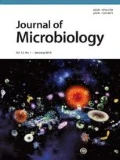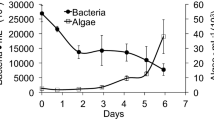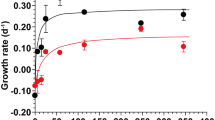Abstract
We measured the grazing and growth response of the mixotrophic chrysomonad flagellate Poterioochromonas malhamensis on four closely related picocyanobacterial strains isolated from subalpine lakes in central Europe. The picocyanobacteria represented different pigment types (phycoerythrin-rich, PE, and phycocyanin-rich, PC) and phylogenetic clusters. The grazing experiments were conducted with laboratory cultures acclimated to 10 µmol photon/m2/sec (low light, LL) and 100 µmol photon/m2/sec (moderate light, ML), either in the dark or at four different irradiances ranging from low (6 µmol photon/m2/sec) to high (1,500 µmol photon/m2/sec) light intensity. Poterioochromonas malhamensis preferred the larger, green PC-rich picocyanobacteria to the smaller, red PE-rich picocyanobacterial, and heterotrophic bacteria. The feeding and growth rates of P. malhamensis were sensitive to the actual light conditions during the experiments; the flagellate performed relatively better in the dark and at LL conditions than at high light intensity. In summary, our results found strain-specific ingestion and growth rates of the flagellate; an effect of the preculturing conditions, and, unexpectedly, a direct adverse effect of high light levels. We conclude that this flagellate may avoid exposure to high surface light intensities commonly encountered in temperate lakes during the summer.
Similar content being viewed by others
Data Availability
The data used to support the findings of this study are available from the corresponding author upon request.
References
Allen, M.M. 1968. Simple conditions for growth of unicellular blue-green algae on plates. J. Phycol.4, 1–4.
Andersson, A., Falk, S., Samuelsson, G., and Hagström, Å. 1989. Nutritional characteristics of a mixotrophic nanoflagellate, Ochromonas sp. Microb. Ecol.17, 251–262.
Beisser, D., Graupner, N., Bock, C., Wodniok, S., Grossmann, L., Vos, M., Sures, B., Rahmann, S., and Boenigk, J. 2017. Comprehensive transcriptome analysis provides new insights into nutritional strategies and phylogenetic relationships of chrysophytes. PeerJ5, e2832.
Bird, D.F. and Kalff, J. 1987. Algal phagotrophy: Regulating factors and importance relative to photosynthesis in Dinobryon (Chrysophyceae). Limnol. Oceanogr.32, 277–284.
Boenigk, J., Matz, C., Jürgens, K., and Arndt, H. 2001a. Confusing selective feeding with differential digestion and bacterivorous nanoflagellates. J. Eukaryot. Microb.48, 425–432.
Boenigk, J., Matz, C., Jürgens, K., and Arndt, H. 2001b. The influence of preculture conditions and food quality on the ingestion and digestion process of three species of heterotrophic nanoflagellates. Microb. Ecol.42, 168–176.
Boenigk, J., Matz, C., Jürgens, K., and Arndt, H. 2002. Food concentration dependent regulation of food selectivity of interception feeding bacterivorous nanoflagellates. Aquat. Microb. Ecol.27, 195–202.
Boenigk, J., Pfandl, K., Stadler, P., and Chatzinotas, A. 2005. High diversity of the ‘Spumella-like’ flagellates: an investigation based on the SSU rRNA gene sequences of isolates from habitats located in six different geographic regions. Environ. Microbiol.7, 685–697.
Boenigk, J., Stadler, P., Wiedlroither, A., and Hahn, M.W. 2004. Strain-specific differences in the grazing sensitivities of closely related ultramicrobacteria affiliated with the Polynucleobacter cluster. Appl. Environ. Microbiol.70, 5787–5793.
Callieri, C. 2017. Synechococcus plasticity under environmental changes. FEMS Microbiol. Lett.364, fnx229.
Callieri, C., Amalfitano, S., Corno, G., and Bertoni, R. 2016. Grazing-induced Synechococcus microcolony formation: experimental insights from two freshwater phylotypes. FEMS Microbiol. Ecol.92, fiw154.
Callieri, C., Coci, M., Corno, G., Macek, M., Modenutti, B., Balseiro, E., and Bertoni, R. 2013. Phylogenetic diversity of nonmarine picocyanobacteria. FEMS Microbiol. Ecol.85, 293–301.
Callieri, C., Moro, S., Caravati, E., Crosbie, N.D., and Weisse, T. 2005. Strain-specific photosynthetic response of freshwater pico-cyanobacteria. Verh. Internat. Verein. Limnol.29, 777–782.
Callieri, C. and Piscia, R. 2002. Photosynthetic efficiency and sea-sonality of autotrophic picoplankton in Lago Maggiore after its recovery. Freshw. Biol.47, 941–956.
Christoffersen, K. 1994. Variations of feeding activities of heterotrophic nanoflagellates on picoplankton. Mar. Microb. Food Web8, 11–123.
Crosbie, N.D., Pöckl, M., and Weisse, T. 2003a. Dispersal and phylogenetic diversity of nonmarine picocyanobacteria, inferred from 16S rRNA gene and cpcBA-intergenic spacer sequence analyses. Appl. Environ. Microb.69, 5716–5721.
Crosbie, N.D., Pöckl, M., and Weisse, T. 2003b. Rapid establishment of clonal isolates of freshwater autotrophic picoplankton by single-cell and single-colony sorting. J. Microbiol. Methods55, 361–370.
Crosbie, N.D., Teubner, K., and Weisse, T. 2003c. Flow-cytometric mapping provides novel insights into the seasonal and vertical distributions of freshwater autotrophic picoplankton. Aquat. Microb. Ecol.33, 53–66.
Elser, J., Kyle, M., Makino, W., Yoshida, T., and Urabe, J. 2003. Ecological stoichiometry in the microbial food web: a test of the light: nutrient hypothesis. Aquat. Microb. Ecol.31, 49–65.
Ernst, A. 1991. Cyanobacterial picoplankton from Lake Constance. I. Isolation by fluorescence characteristics. J. Plankton Res.13, 1307–1312.
Fogg, G.E. 1986. Picoplankton. Proc. R. Soc. Lond.228, 1–30.
Gervais, F., Padisák, J., and Koschel, R. 1997. Do light quality and low nutrient concentration favour picocyanobacteria below the thermocline of the oligotrophic Lake Stechlin? J. Plankton Res.19, 771–781.
Hahn, M.W. and Höfle, M.G. 1998. Grazing pressure by a bacterivorous flagellate reverses the relative abundance of Comamonas acidovorans PX54 and Vibrio strain CB5 in chemostat cocultures. Appl. Environ. Microbiol.64, 1910–1918.
Hahn, M.W. and Höfle, M.G. 1999. Flagellate predation on a bacterial model community: Interplay of size-selective grazing, specific bacterial cell size, and bacterial community composition. Appl. Environ. Microbiol.65, 4863–4872.
Hahn, M.W. and Höfle, M.G. 2001. Grazing of protozoa and its effect on populations of aquatic bacteria. FEMS Microbiol. Ecol.35, 113–121.
Holen, D.A. and Boraas, M. 1991. The feeding behavior of Spumella sp. as a function of particle size: Implications for bacterial size in pelagic systems. Hydrobiologia220, 73–88.
Holling, C.S. 1959. The components of predation as revealed by a study of small-mammal predation of the European pine sawfly. Can. Entomol.91, 293–320.
Ivanikova, N.V., Popels, L.C., McKay, R.M.L., and Bullerjahn, G.S. 2007. Lake Superior supports novel clusters of cyanobacterial picoplankton. Appl. Environ. Microbiol.73, 4055–4065.
Jacobs, J. 1974. Quantitative measurement of food selection: a modification of the forage ratio and Ivlev’s selectivity index. Oecologia14, 413–417.
John, E.H. and Davidson, K. 2001. Prey selectivity and the influence of prey carbon: nitrogen ratio on microflagellate grazing. J. Exp. Mar. Biol. Ecol.260, 93–111.
Jones, R.I. 2000. Mixotrophy in planktonic protists: an overview. Freshw. Biol.45, 219–226.
Jürgens, K. and Massana, R. 2008. Protist Grazing on Marine Bacterioplankon. In Kirchman, D.L. (eds.) Microbial Ecology of the Oceans. 2nd ed., pp. 383–441. John Wiley & Sons, Inc.
Jürgens, K. and Šimek, K. 2000. Functional response and particle size selection of Halteria cf. grandinella, a common freshwater oligotrichous ciliate. Aquat. Microb. Ecol.22, 57–68.
Li, J., Fenton, A., Kettley, L., Roberts, P., and Montagnes, D.J.S. 2013. Reconsidering the importance of the past in predator-prey models: both numerical and functional responses depend on delayed prey densities. Proc. R. Soc. B.280, 20191389.
Lie, A.A., Liu, Z., Terrado, R., Tatters, A.O., Heidelberg, K.B., and Caron, D.A. 2017. Effect of light and prey availability on gene expression of the mixotrophic chrysophyte, Ochromonas sp. BMC Genomics18, 163.
Malinsky-Rushanksy, N., Berman, T., Berner, T., Yacobi, Y.Z., and Dubinsky, Z. 2002. Physiological characteristics of picophytoplankton, isolated from Lake Kinneret: responses to light and temperature. J. Plankton Res.24, 1173–1183.
Meunier, C.L., Hantzsche, F.M., Cunha-Dupont, A.Ö., Haafke, J., Oppermann, B., Malzahn, A.M., and Boersma, M. 2012. Intraspecific selectivity, compensatory feeding and flexible homeostasis in the phagotrophic flagellate Oxyrrhis marina: three ways to handle food quality fluctuations. Hydrobiologia680, 53–62.
Montagnes, D.J.S., Barbosa, A.B., Boenigk, J., Davidson, K., Jürgens, K., Macek, M., Parry, J.D., Roberts, E.C., and Simek, K. 2008. Selective feeding behaviour of free-living protists: avenues for continued study. Aquat. Microb. Ecol.53, 83–98.
Moreno, A.R. and Martiny, A.C. 2018. Ecological stoichiometry of ocean plankton. Ann. Rev. Mar. Sci.10, 43–69.
Moser, M., Callieri, C., and Weisse, T. 2009. Photosynthetic and growth response of freshwater picocyanobacteria are strain-specific and sensitive to photoacclimation. J. Plankton Res.31, 349–357.
Müller, H. 1996. Selective feeding of a freshwater chrysomonad, Paraphysomonas sp., on chroococcoid cyanobacteria and nano-flagellates. Archiv. Hydrobiol. Adv. Limnol.48, 63–71.
Neale, P.J. and Richerson, P.J. 1987. Photoinhibition and the diurnal variation of phytoplankton photosynthesis-I. Development of a photosynthesis-irradiance model from studies of in situ responses. J. Plankton Res.9, 167–193.
Padisák, J. 2003. Phytoplankton. In O’Sullivan, P. and Reynolds, C.S. (eds.), The lakes handbook: limnology and limnetic ecology. vol. 1, pp. 251–308. Blackwell Science Ltd.
Pålsson, C. and Daniel, C. 2004. Effects of prey abundance and light intensity on nutrition of a mixotrophic flagellate and its competitive relationship with an obligate heterotroph. Aquat. Microb. Ecol.36, 247–256.
Pernthaler, J., Simek, K., Sattler, B., Schwarzenbacher, A., Bobková J., and Psenner, R. 1996. Short-term changes of protozoan control on autotrophic picoplankton in an oligo-mesotrophic lake. J. Plankton Res.18, 443–462.
Pestová, D., Macek, M., and Pérez, M.E.M. 2008. Ciliates and their picophytoplankton-feeding activity in a high-altitude warm-monomictic saline lake. Eur. J. Protistol.44, 13–25.
Ptacnik, R., Gomes, A., Royer, S.J., Berger, S.A., Calbet, A., Nejstgaard, J.C., Gasol, J.M., Isari, S., Moorthi, S.D., Ptacnikova, R., et al. 2016. A light-induced shortcut in the planktonic microbial loop. Sci. Rep.6, 29286.
Rigler, F.H. 1961. The relation between concentration of food and feeding rate of Daphnia magna straus. Can. J. Zool.39, 857–868.
Rothhaupt, K.O. 1990. Changes of the functional responses of the rotifers Brachionus rubens and Brachionus calyciflorus with particle sizes. Limnol. Oceanogr.35, 24–32.
Rottberger, J., Gruber, A., Boenigk, J., and Kroth, P.G. 2013. Influence of nutrients and light on autotrophic, mixotrophic and heterotrophic freshwater chrysophytes. Aquat. Microb. Ecol.71, 179–191.
Sanders, R.W., Porter, K.G., and Caron, D.A. 1990. Relationship between phototrophy and phagotrophy in the mixotrophic chrysophyte Poterioochromonas malhamensis. Microb. Ecol.19, 97–109.
Scanlan, D.J. and West, N.J. 2002. Molecular ecology of the marine cyanobacterial genera Prochlorococcus and Synechococcus. FEMS Microbiol. Ecol.40, 1–12.
Schmidtke, A., Bell, E.M., and Weithoff, G. 2006. Potential grazing impact of the mixotrophic flagellate Ochromonas sp. (Chrysophyceae) on bacteria in an extremely acidic lake. J. Plankton Res.28, 991–1001.
Shannon, S.P., Chrzanowski, T.H., and Grover, J.P. 2007. Prey food quality affects flagellate ingestion rates. Microb. Ecol.53, 66–73.
Šimek, K., Bobková, J., Macek, M., Nedoma, J., and Psenner, R. 1995. Ciliate grazing on picoplankton in a eutrophic reservoir during the summer phytoplankton maximum: a study at the species and community level. Limnol. Oceanogr.40, 1077–1090.
Šimek, K., Pernthaler, J., Weinbauer, M.G., Hornák, K., Dolan, J.R., Nedoma, J., Masín, M., and Amann, R. 2001. Changes in bacterial community composition and dynamics and viral mortality rates associated with enhanced flagellate grazing in a mesoeutrophic reservoir. Appl. Environ. Microbiol.67, 2723–2733.
Sommer, U., Gaedke, U., and Schweizer, A. 1993. The first decade of oligotrophication of Lake Constance: II. The response of phytoplankton taxonomic composition. Oecologia93, 276–284.
Sterner, R.W., Clasen, J., Lampert, W., and Weisse, T. 1998. Carbon: phosphorus stoichiometry and food chain production. Ecol. Lett.1, 146–150.
Sterner, R.W., Elser, J.J., Fee, E.J., Guildford, S.J., and Chrzanowski, T.H. 1997. The light: nutrient ratio in lakes: the balance of energy and materials affects ecosystem structure and process. Am. Nat.150, 663–684.
Stockner, J.G. and Antia, N.J. 1986. Algal picoplankton from marine and freshwater ecosystems: a multidisciplinary perspective. Can. J. Fish. Aquat. Sci.43, 2472–2503.
Suttle, C.A., Chan, A.M., Taylor, W.D., and Harrison, P.J. 1986. Grazing of planktonic diatoms by microflagellates. J. Plankton Res.8, 393–398.
Tarao, M., Jezbera, J., and Hahn, M.W. 2009. Involvement of cell surface structures in size-independent grazing resistance of fresh-water Actinobacteria. Appl. Environ. Microbiol.75, 4720–4726.
Tilzer, M.M. 1987. Light-dependence of photosynthesis and growth in cyanobacteria: implications for their dominance in eutrophic lakes. New Zeal. J. Mar. Fresh. Res.21, 401–412.
Tilzer, M.M. and Beese, B. 1988. The seasonal productivity cycle of phytoplankton and controlling factors in lake Constance. Swiss J. Hydrol.50, 1–39.
Wacker, A., Piepho, M., Harwood, J.L., Guschina, I.A., and Arts, M.T. 2016. Light-induced changes in fatty acid profiles of specific lipid classes in several freshwater phytoplankton species. Front. Plant Sci.7, 264.
Weisse, T. 1988. Dynamics of autotrophic picoplankton in lake Constance. J. Plankton Res.10, 1179–1188.
Weisse, T. 1993. Dynamics of autotrophic picoplankton in marine and freshwater ecosystems. Adv. Microb. Ecol.13, 327–370.
Weisse, T., Anderson, R., Arndt, H., Calbet, A., Hansen, P.J., and Montagnes, D.J.S. 2016. Functional ecology of aquatic phagotrophic protists — concepts, limitations, and perspectives. Eur. J. Protistol.55, 50–74.
Weisse, T. and Bergkemper, V. 2018. Rapid detection and quantification of the potentially toxic cyanobacterium Planktothrix rubescens by in-vivo fluorometry and flow cytometry. Water Res.138, 234–240.
Weisse, T., Müller, H., Pinto-Coelho, R.M., Schweizer, A., Springmann, D., and Baldringer, G. 1990. Response of the microbial loop to the phytoplankton spring bloom in a large prealpine lake. Limnol. Oceanogr.35, 781–794.
Zwirglmaier, K., Spence, E., Zubkov, M.V., Scanlan, D.J., and Mann, N.H. 2009. Differential grazing of two heterotrophic nanoflagellates on marine Synechococcus strains. Environ. Microbiol.11, 1767–1776.
Acknowledgments
We thank Annette Ernst, Nicholas Crosbie, and Peter Stadler for isolating and maintaining the picocyanobacterial cultures used in this study, and Martin Hahn for providing the axenic P. malhamensis strain DS. Cristiana Callieri, CNR-ISE Pallanza, Italy, provided the facilities to measure the growth and grazing rates along a light gradient.
Author information
Authors and Affiliations
Corresponding author
Ethics declarations
The authors declare that they have no conflicts of interest.
Additional information
Supplemental material for this article may be found at http://www.springerlink.com/content/120956.
Electronic Supplementary Material
Rights and permissions
About this article
Cite this article
Weisse, T., Moser, M. Light affects picocyanobacterial grazing and growth response of the mixotrophic flagellate Poterioochromonas malhamensis. J Microbiol. 58, 268–278 (2020). https://doi.org/10.1007/s12275-020-9567-8
Received:
Revised:
Accepted:
Published:
Issue Date:
DOI: https://doi.org/10.1007/s12275-020-9567-8




